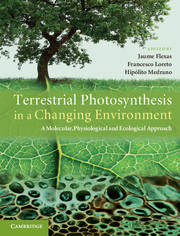 Terrestrial Photosynthesis in a Changing Environment
Terrestrial Photosynthesis in a Changing Environment Published online by Cambridge University Press: 05 March 2013
Chilling and freezing temperatures
Low temperatures represent a major abiotic constraint to the distribution, development and productivity of many plant species. Plants have evolved adaptations to cope with chilling or freezing and to be able to acclimate to low temperature (Allen and Ort 2001; Wisniewski et al., 2003; Slot et al., 2005; Ruelland et al., 2009). These include dormancy, rapid acclimation and maintenance of cold hardiness during prolonged low-temperature or freezing periods (Howe et al., 2003; Wisniewski et al., 2003). The responses to chilling differ from the responses to freezing temperatures. In temperate regions, chilling refers to non-freezing temperatures (0–12°C) during the growing season with the lowest temperatures typically occurring during the night (Allen and Ort, 2001). In contrast, freezing or frost requires temperatures below 0°C. Adaptation to freezing includes mechanisms to prevent freezing injuries from the formation of ice inside the plant cell, which would result in deleterious damage or death of the cell (for recent reviews on acclimation to freezing temperatures see Kalberer et al., 2006; Thomashow, 1999; Xin and Browse, 2000). Other mechanisms involved in this process include e.g., changes in lipid composition or the reactive-oxygen-scavenging-system. Together this suite of acclimation responses involving various metabolic, physiological and developmental aspects is called cold hardening or cold acclimation (Xin and Browse, 2000).
The ability of a species to acclimate to low temperatures via the cold hardening process allows one to distinguish cold-hardy from non-hardy plants, e.g., plants that have the genetic capacity to acclimate to chilling or freezing versus plants lacking this genetic information (Allen and Ort, 2001). These cold-hardy plants are typically from cold or temperate environments. Importantly, even cold-tolerant plants are at risk of being killed by low temperatures. For example, unhardened wheat plants, which are genetically adapted to sustain freezing temperatures, will not be able to survive temperatures of –5°C if they are not acclimated to low temperatures through an adequate cold-hardening period (Thomashow, 1999).
To save this book to your Kindle, first ensure [email protected] is added to your Approved Personal Document E-mail List under your Personal Document Settings on the Manage Your Content and Devices page of your Amazon account. Then enter the ‘name’ part of your Kindle email address below. Find out more about saving to your Kindle.
Note you can select to save to either the @free.kindle.com or @kindle.com variations. ‘@free.kindle.com’ emails are free but can only be saved to your device when it is connected to wi-fi. ‘@kindle.com’ emails can be delivered even when you are not connected to wi-fi, but note that service fees apply.
Find out more about the Kindle Personal Document Service.
To save content items to your account, please confirm that you agree to abide by our usage policies. If this is the first time you use this feature, you will be asked to authorise Cambridge Core to connect with your account. Find out more about saving content to Dropbox.
To save content items to your account, please confirm that you agree to abide by our usage policies. If this is the first time you use this feature, you will be asked to authorise Cambridge Core to connect with your account. Find out more about saving content to Google Drive.